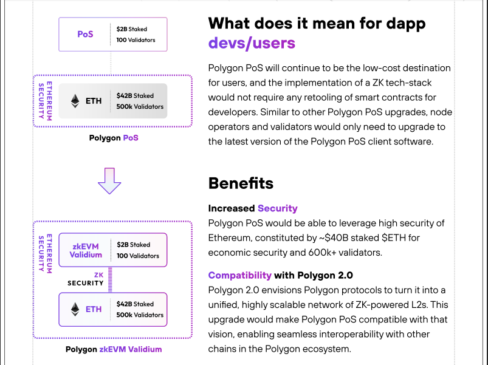Polygon co-founder Jordi Baylina says 2024 will see the amalgamation of Polygon’s various Ethereum layer 2 scaling networks to complete its “Polygon 2.0” cross-chain coordination protocol.
Speaking exclusively to Cryptox, Baylina said next year will be a litmus test to see how the Polygon ecosystem’s various networks can scale and integrate through the implementation of zero-knowledge proofs (ZK-proofs):
“2024 is going to be very much about Polygon 2.0, having all these networks connected, sharing the liquidity, sharing the composability between the network with different flavors.”
Baylina added that several of the networks that make up Polygon’s ecosystem feature their own respective tokens, sequencers and data availability solutions. The evolution to Polygon 2.0 is set to include several upgrades that will unify these different protocols with ZK-proof technology into “continuous, unbounded blockspace.”
The scaling technology firm unveiled Polygon 2.0 in June 2023, outlining plans for a scaling ecosystem comprising four protocol layers. The staking, interop, execution and proving layers all play a role in creating an interconnected ecosystem of chains that enable fast value transfer and information sharing.
Related: Polygon co-founder: $1B bet on ZK-rollups paying off
2023 has been an important year for Polygon, as Baylina reflects, as several products have been shipped that have added to the performance of its scaling protocol and provide the means for developers to build decentralized applications (DApps) and interoperable services.
“This has been an incredible year for Polygon, the zkEVM was like the first big event. Also the creation, design and announcement of Polygon 2.0 with the proof-of-stake (PoS) integration and all these aggregation layers, is an important milestone,” Baylina explains.
Polygon released its open-source zkEVM mainnet beta in March 2023, which delivers reduced transaction costs and increased throughput of smart contract deployments. The technology allows thousands of transactions to be batched off-chain, with cryptographic proof containing a minimal data summary posted to the Ethereum mainnet.
Polygon’s zkEVM mimics the transaction execution environment of Ethereum’s mainnet. The open-source zkEVM allows DApps to scale through transaction batching, unlocking higher performance.
The release of Polygon’s Chain Development Kit (CDK) in Sept. 2023 dramatically opened the ecosystem to new development. Baylina previously spoke to Cryptox on the introduction of the service, which allows developers to launch bespoke ZK-powered layer 2 protocols on Ethereum, tailored to the requirements of their project.
A key aspect is that Polygon CDK enables automatic access to liquidity across all of Polygon’s chains and the broader Ethereum ecosystem, providing “on-demand scale, without fragmenting liquidity.”
Baylina described the current state of Polygon as a “constellation with a single star being the zkEVM.” The transition of Polygon PoS to a zkEVM validium will expedite the scaling of the network and allow ecosystem protocols to become interconnected.
“It is complex. It’s not an easy task. Polygon is a decentralized system. So first, there needs to be consensus for the switch. Then comes moving all the bridges, continuing the network, and giving continuity to all these applications. This is challenging,” Baylina adds.
Polygon released three Polygon Improvement Proposals (PIPs) in Sept. 2023. This includes a proposal for the transition and specifications that will see MATIC tokens become POL tokens, which will become the Polygon proof-of-stake (PoS) protocol’s native token.
PIP-17 will include the initiation of the upgrade from MATIC to POL. This includes its transition to POL as the native gas token and staking token for the Polygon ecosystem, as well as the launch of the staking layer and migration of Polygon public chains.
Magazine: Slumdog billionaire: Incredible rags-to-riches tale of Polygon’s Sandeep Nailwal



